DIN 4102 – Building Materials Fire Resistance Test
When selecting appropriate fire resistance tests for building materials in the oil and gas sector, it is crucial to consider standards that reflect real-world conditions. DIN 4102 is a widely recognized standard in Germany and other European countries for evaluating the fire resistance of building materials. This test is essential for ensuring compliance with local regulations and enhancing safety protocols.
The DIN 4102 method involves subjecting specimens to controlled laboratory fires to assess their ability to resist ignition, maintain stability, and prevent the spread of flames. This standard focuses on structural integrity under fire exposure conditions that are relevant to oil and gas facilities. Compliance with this test ensures that materials can withstand extreme heat without compromising safety or performance.
The testing procedure typically involves preparing specimens according to specified dimensions and placing them in a furnace where they undergo controlled heating over several hours. The temperature, duration, and environment within the furnace are carefully regulated to simulate realistic fire scenarios. Upon completion of the test, experts evaluate various parameters such as structural stability, flame spread, smoke production, and heat release rate.
Understanding the importance of this test extends beyond mere compliance; it plays a pivotal role in safeguarding lives and property during emergencies within oil and gas installations. By adhering to DIN 4102 requirements, manufacturers ensure that their products contribute positively to fire safety measures. This not only protects end-users but also supports overall facility resilience against potential hazards.
Moreover, successful outcomes from DIN 4102 testing can significantly enhance a company’s reputation among stakeholders by demonstrating commitment to high-quality standards and sustainable practices. In competitive markets where reliability matters most, passing such rigorous tests becomes an asset that sets brands apart from competitors offering less robust solutions.
Why It Matters
In the context of oil and gas operations, fire resistance testing is critical for ensuring safety measures are in place to protect both personnel and assets. The DIN 4102 standard provides a structured approach to assessing building materials’ performance under intense heat conditions, which is particularly relevant given the volatile nature of oil and gas environments.
By adhering to this stringent test protocol, companies can confirm that their materials will maintain structural integrity during fires, thereby minimizing risk factors associated with compromised structures. Additionally, compliance helps meet regulatory requirements set forth by governing bodies responsible for occupational health and safety standards.
The significance of DIN 4102 lies in its ability to provide a reliable benchmark against which material quality can be evaluated consistently across different suppliers and locations. This consistency fosters trust between manufacturers and end-users while facilitating smoother supply chain management processes. Ultimately, compliance with these rigorous tests contributes significantly towards enhancing overall operational reliability within complex industrial settings.
Why Choose This Test
- Ensures regulatory compliance with international standards.
- Provides consistent and reliable evaluation of building material fire resistance.
- Supports safer environments for personnel working in oil and gas facilities.
- Maintains structural integrity during intense heat conditions.
- Facilitates smoother supply chain management through standardized testing processes.
- Enhances overall operational reliability within complex industrial settings.
The DIN 4102 test is particularly advantageous for manufacturers looking to demonstrate their commitment to quality and safety. By choosing this rigorous evaluation process, they can ensure that their products meet the highest standards of performance and durability required by industry regulations.
Competitive Advantage and Market Impact
Incorporating DIN 4102 testing into one’s quality assurance program offers several strategic benefits. First and foremost, it positions a company at the forefront of innovation by adhering to stringent international standards. This not only enhances brand reputation but also differentiates offerings from competitors who may lack such comprehensive testing protocols.
Furthermore, successful completion of this test can lead to increased market share as buyers increasingly prioritize safety features when selecting suppliers. By showcasing compliance with DIN 4102 requirements, businesses signal their dedication to maintaining the highest level of product performance and reliability—qualities that are particularly valued in high-risk industries like oil and gas.
From a long-term perspective, investing in DIN 4102 testing demonstrates foresight regarding potential risks associated with fire incidents. Such proactive measures can prevent costly disruptions caused by non-compliant materials or defective products, thereby safeguarding both reputation and profitability.





